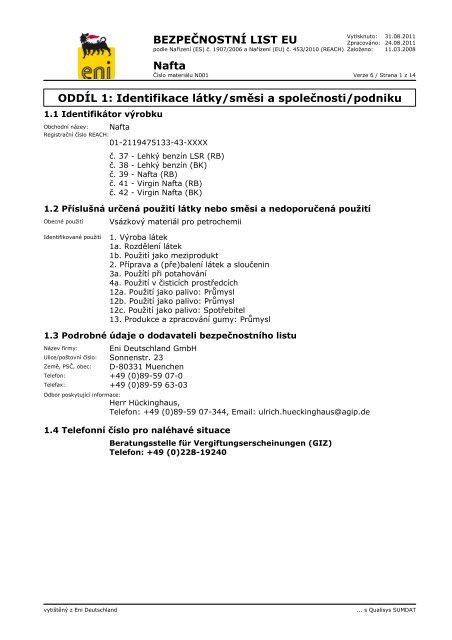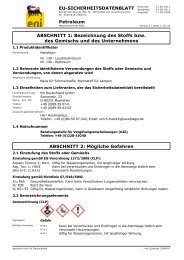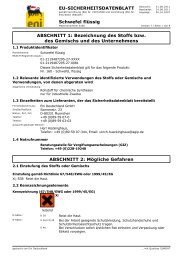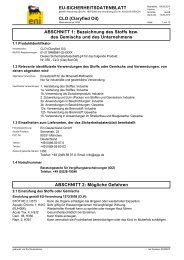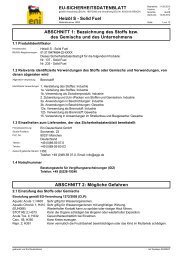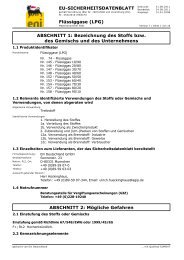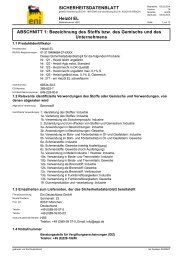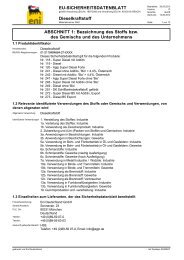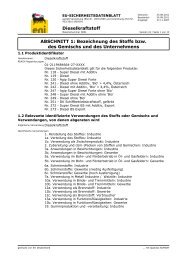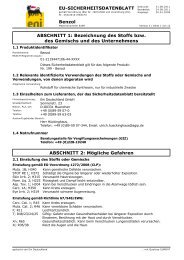Sicherheitsdatenblatt N001 (CZ
Sicherheitsdatenblatt N001 (CZ
Sicherheitsdatenblatt N001 (CZ
Create successful ePaper yourself
Turn your PDF publications into a flip-book with our unique Google optimized e-Paper software.
BEZPEČNOSTNÍ LIST EUpodle Nařízení (ES) č. 1907/2006 a Nařízení (EU) č. 453/2010 (REACH)Vytisknuto: 31.08.2011Zpracováno: 24.08.2011Založeno: 11.03.2008NaftaČíslo materiálu <strong>N001</strong>Verze 6 / Strana 3 z 14Značení (67/548/EHS nebo 1999/45/ES)FT Nvysoce hořlavýnebezpečný pro životní prostředíR-věty: R 45 Může vyvolat rakovinu.R 46 Může vyvolat poškození dědičných vlastností.R 11 Vysoce hořlavý.R 38 Dráždí kůži.R 51/53 Toxický pro vodní organismy, může vyvolat dlouhodobé nepříznivéúčinky ve vodním prostředí.R 65 Zdraví škodlivý: při požití může vyvolat poškození plic.R 67 Vdechování par může způsobit ospalost a závratě.S-věty: S 53 Zamezte expozici - před použitím si obstarejte speciální instrukce.S 2 Uchovávejte mimo dosah dětí.S 23 Nevdechujte páry.S 24 Zamezte styku s kůží.S 29 Nevylévejte do kanalizace.S 36/37 Používejte vhodný ochranný oděv a ochranné rukavice.S 43 V případě požáru použijte Pěna, suché hasivo, proud vody nebopoužít oxid uhličitý.S 45 V případě nehody, nebo necítíte-li se dobře, okamžitě vyhledejtelékařskou pomoc.S 51 Používejte pouze v dobře větraných prostorách.S 61 Zabraňte uvolnění do životního prostředí. Viz speciální pokynynebo bezpečnostní listy.S 62 Při požití nevyvolávejte zvracení: okamžitě vyhledejte lékařskoupomoc a ukažte tento obal nebo označení.2.3 Další nebezpečnostPáry jsou těžší než vzduch, šíří se při zemi.I při nízkých teplotách okolního prostředí mohou vznikat výbušné směsipar/vzduchu.3.1 LátkyODDÍL 3: Složení/ informace o složkáchChemická charakteristika (látka):nafta, s nízkým bodem varuUVCB látka - Informace o složkách:Obsažená látka Označení Obsah ZnačeníEINECS 265-065-1CAS 64741-63-5REACH01-2119474679-18-xxxxEINECS 265-042-6CAS 64741-42-0Benzinovafrakce (ropna),lehkakatalytickyreformovanaBenzinovafrakce (ropna),primarni sirokafrakce0-100 % EU: Carc. Cat. 2; R45.Muta. Cat. 2; R46. Xn; R65.CLP: Muta. 1B; H340.Carc. 1B; H350.Asp. Tox. 1; H304.0-100 % EU: Carc. Cat. 2; R45.Muta. Cat. 2; R46. Xn; R65.CLP: Muta. 1B; H340.Carc. 1B; H350.Asp. Tox. 1; H304.vytištěný z Eni Deutschland... s Qualisys SUMDAT
BEZPEČNOSTNÍ LIST EUpodle Nařízení (ES) č. 1907/2006 a Nařízení (EU) č. 453/2010 (REACH)Vytisknuto: 31.08.2011Zpracováno: 24.08.2011Založeno: 11.03.2008NaftaČíslo materiálu <strong>N001</strong>Verze 6 / Strana 4 z 14Obsažená látka Označení Obsah ZnačeníEINECS 265-151-9CAS 64742-49-0EINECS 265-046-8CAS 64741-46-4EINECS 265-041-0CAS 64741-41-9EINECS 270-690-8CAS 68476-50-6REACH01-2119447106-44-xxxxEINECS 200-753-7CAS 71-43-2Nafta(petrolej),mírně upravenávodíkemBenzinovafrakce (ropna),lehka primarniBenzinovafrakce (ropna),tezka primarniUhlovodiky, C>=5, bohatena C5-6Benzen >=0,1 %0-100 % EU: Carc. Cat. 2; R45.Muta. Cat. 2; R46. Xn; R65.CLP: Muta. 1B; H340.Carc. 1B; H350.Asp. Tox. 1; H304.0-100 % EU: Carc. Cat. 2; R45.Muta. Cat. 2; R46. Xn; R65.CLP: Muta. 1B; H340.Carc. 1B; H350.Asp. Tox. 1; H304.0-100 % EU: Carc. Cat. 2; R45.Muta. Cat. 2; R46. Xn; R65.CLP: Muta. 1B; H340.Carc. 1B; H350.Asp. Tox. 1; H304.0-100 % EU: Carc. Cat. 2; R45.Muta. Cat. 2; R46. Xn; R65.CLP: Muta. 1B; H340.Carc. 1B; H350.Asp. Tox. 1; H304.EU: Carc. Cat. 1; R45.F; R11. Muta. Cat. 2; R46.Xn; R65. T; R48/23/24/25.Xi; R36/38.CLP: Asp. Tox. 1; H304.Carc. 1A; H350.Eye Irrit. 2; H319.Flam. Liq. 2; H225.Muta. 1B; H340.STOT RE 1; H372.Skin Irrit. 2; H315.Dodatečná upozornění: Může podle doměnek způsobit omezení plodnosti nebo poškodit dítě vmateřském lůně. testCAS 64741-63-5 - Chemiebenzin:Směs uhlovodíků, C5-C11, Rozmezí varu 35°C do 190°CCAS 64741-42-0 - Full Range Naphtha:Směs uhlovodíků, C4-C11, Rozmezí varu-20°C do 220°CCAS 64742-49-0 - Light Distillate Feedstock:Směs uhlovodíků, C4-C11, Rozmezí varu-20°C do 190°CCAS 64741-46-4-5 - Light Virgin Naphtha:Směs uhlovodíků, C4-C10, Rozmezí varu-20°C do 180°CCAS 64741-41-9 - Mittelbenzin:Směs uhlovodíků, C6-C12, Rozmezí varu 65°C do 230°CCAS 68476-50-6 - Leichtbenzin:Směs uhlovodíků, >= C5vytištěný z Eni Deutschland... s Qualisys SUMDAT
BEZPEČNOSTNÍ LIST EUpodle Nařízení (ES) č. 1907/2006 a Nařízení (EU) č. 453/2010 (REACH)Vytisknuto: 31.08.2011Zpracováno: 24.08.2011Založeno: 11.03.2008NaftaČíslo materiálu <strong>N001</strong>Verze 6 / Strana 5 z 144.1 Popis první pomociVšeobecné pokyny:Vdechování:Při styku s pokožkou:Při styku s očima:Po polknutí:ODDÍL 4: Pokyny pro první pomocPrvní pokyn : Dbát vlastní ochranyInhalace větších množství způsobí: Porucha koordinace, opojení, bolest hlavy,nutkání ke zvracení.Při delší expozici: závrať, bezvědomí a zástava dechu možný.Postižené přivést na čerstvý vzduch.Při dýchacích obtížích zabezpečit přísun kyslíku. při nepravidelném dýchánínebo při zástavě dechu poskytněte umělé dýchání. Okamžitě přivolejtelékaře.Při nebezpečí ztráty vědomí uložit a transportovat ve stabilizované poloze.Okamžitě odložte veškeré kontaminované oblečení.Při styku s pokožkou okamžitě opláchnout proudem vody a mýdlem. Připodráždění pokožky vyhledat lékaře.Při otevřených víčkách vyplachovat 10-15 minut tekoucí vodou. Potom seporadit s očním lékařem.Nevyvolávat zvracení. Při spolknutí resp. zvracení nebezpečí vniknutí do plic.V případě zvracení a při bezvědomí uvést do stabilizované polohy. Udržovatvolný průchod dýchácích cest. Okamžitě přivolejte lékaře.4.2 Nejdůležitější akutní a opožděné symptomy a účinkyVdechování:Bolest hlavy, stav opojení, nevolnost, otupělost, závrať, dýchací potíže.Při vyšších koncentracích se vyskytuje: Poruchy CNS, bezvědomí, narkóza,zástava dechu.Po polknutí: žaludeční-střevní-poruchy, průjem.4.3 Pokyn týkající se okamžité lékařské pomoci a zvláštního ošetřeníMůžou nastat následující symptomy: Bolest hlavy, stav opojení, nevolnost,nutkání ke zvracení, otupělost, závrať, dýchací potíže, bezvědomí, zástavadechu.Při polknutí s následným dávením může dojít k vdechnutí do plic, což můževést k chemické pneumonii nebo k zadušení.Ošetření:Případné kyslíkové umělé dýchání.Při podráždění plic nejdříve ošetřete sprejem Dexamethason.5.1 HasivaODDÍL 5: Opatření pro hašení požáruVhodné hasicí prostředky:Pěna, suché hasivo (ABC-prášek), proud vody, oxid uhličitý.Z bezpečnostních důvodů nevhodné hasicí prostředky:Silný vodní proud5.2 Zvláštní nebezpečnost vyplývající z látky nebo směsiVysoce hořlavý.Mohou vznikat výbušné směsi par/vzduchu. Pozor na zpětný zápal.V případě požáru mohou vznikat: Oxidy dusíku (NOx), oxidy síry, oxiduhelnatý a oxid uhličitý.vytištěný z Eni Deutschland... s Qualisys SUMDAT
BEZPEČNOSTNÍ LIST EUpodle Nařízení (ES) č. 1907/2006 a Nařízení (EU) č. 453/2010 (REACH)Vytisknuto: 31.08.2011Zpracováno: 24.08.2011Založeno: 11.03.2008NaftaČíslo materiálu <strong>N001</strong>Verze 6 / Strana 6 z 145.3 Pokyny pro hasičeZvláštní ochranné vybavení při hašení požáru:Použijte autonomní dýchací přístroj a protichemický ochranný oděv.Dodatečná upozornění: Ohrožené nádoby ochlazovat vodním proudem. V případě požáru nebovýbuchu nevdechujte dýmy.Kontaminovanou vodu na hašení sbírejte odděleně. Zamezit vniknutí hasícívody do povrchové a podzemní vody.ODDÍL 6: Opatření v případě náhodného úniku6.1 Opatrení na ochranu osob, ochranné prostredky a nouzové postupyZamezit kontaktu s látkou. Nosit vhodný ochranný oděv.Přiveďte osoby do bezpečí. Nechráněné osoby musí zůstat v dostatečnévzdálenosti.Zajistěte dostatečné větrání. Nevdechujte páry.6.2 Opatření na ochranu životního prostředíZamezte plošné expanzi (např. zahrazením nebo zablokováním). Zabránitvniknutí do půdy, vody a kanalizace. Nebezpečí exploze! Při uvolněníinformovat úřady.6.3 Metody a materiál pro omezení úniku a pro čištěníOdstraňte z povchu vody (např. odčerpáním, odsátím).Odklízet nehořlavým, kapaliny sajícím materiálem (např. písek/zemina/křemelina/Vermiculit) a podle předpisu likvidovat.Nevymývat vodou nebo vodou zředěnou čisticími prostředky.Dodatečná upozornění: Odstraňte všechny zdroje vznícení. Pozor na zpětný zápal. Použijte jiskrověbezpečné nářadí.6.4 Odkaz na jiné oddílyZvláštní nebezpečí uklouznutí na rozsypaném/vylitém produktu.nepotřebný7.1 Opatření pro bezpečné zacházeníODDÍL 7: Zacházení a skladováníPokyny k bezpečnému zacházeníDbát na dobré větrání a vyvětrání skladu a pracoviště.Při manipulaci zabránit vystříknutí a rozlití.Zamezit tvorbě aerosolu a mlhy. Nevdechujte páry.Nejezte, nepijte a nekuřte při používání. Nikdy nepoužívejte k čistícím účelům.Pokyny k ochraně před požárem a explozí:Uchovávejte mimo dosah zdrojů zapálení - Zákaz kouření. Proveďtepreventivní opatření proti výbojům statické elektřiny. Pamatujte na uzemněnínádrže, aparatur, čerpadel a odsávacích zařízení. Používejte jen antistatickyvybavené (nejiskřící) nářadí. Je potřebné použít antistatický pracovní oděv.vytištěný z Eni Deutschland... s Qualisys SUMDAT
BEZPEČNOSTNÍ LIST EUpodle Nařízení (ES) č. 1907/2006 a Nařízení (EU) č. 453/2010 (REACH)Vytisknuto: 31.08.2011Zpracováno: 24.08.2011Založeno: 11.03.2008NaftaČíslo materiálu <strong>N001</strong>Verze 6 / Strana 7 z 147.2 Podmínky pro bezpečné skladování látek a směsí včetně neslučitelnýchlátek a směsíPožadavky na skladovací prostory a nádoby:Uchovávejte obal těsně uzavřený , na dobře větraném místě.Dodržujte dostatečnou vzdálenost od zápalných a tepelných zdrojů.Vhodný materiál: ocel, Povolené rezervní kanystryPřístup do skladu povolen pouze odborníkům.Pokyny pro společné skladováníNeskladovat společně s látkami podporujícími hoření, se samovznětlivýmilátkami a se snadno vznětlivými pevnými látkami.Třída skladování VCI:3 = Zápalné kapalné látky7.3 Specifické konečné / specifická konečná použitíVsázkový materiál pro petrochemiiODDÍL 8: Omezování expozice/osobní ochranné prostředky8.1 Kontrolní parametryCAS-číslo Označení Druh Hraniční hodnota71-43-2 Benzen Česká republika: PEL D, P 3 mg/m3; 0,939 ppmČeská republika: NPK-LEvropa, BOELV: TWAD, P 10 mg/m3; 3,13 ppmPokožka 3,25 mg/m3; 1 ppmDodatečná upozornění: hraniční hodnota motorový benzín (Analogický závěr): 250 mg/m3(Mezní hodnota pro motorová paliva podle DIN EN 228 je mezní hodnotasoučtu všech uhlovodíků včetně benzolu a všech složek obsahujících kyslík.)DNELDNEL Krátkodobý, pracovník, inhalativní: 1300 mg/m3 / 15 (4320 mg/m3/h)DNEL Krátkodobý, pracovník, inhalativní: 1110 mg/m3 / 15 (2400 mg/m3/h)DNEL Dlouhodobý, pracovník, inhalativní: 840 mg/m3 / 8h (10000 mg/m3/6h)DNEL Krátkodobý, spotřebitel, inhalativní: 1200 mg/m3 / 15(4320 mg/m3/h)DNEL Krátkodobý, spotřebitel, inhalativní: 640 mg/m3 / 15 (2400 mg/m3/h)DNEL Dlouhodobý, spotřebitel, inhalativní: 180 mg/m3 / 8h (10000 mg/m3/6h)8.2 Omezování expoziceZajistit dobré větrání místnosti, odsávání/vyvětrání.Nouzová sprcha a prostředky na výplach očí by měly být v pracovnímprostoru snadno přístupné.Látka by měla být zpracovávána jen v uzavřeném zařízení nebo systému.Omezování expozice pracovníkůOchrana dýchacích orgánů:Při vyšších koncentracích se vyskytuje:Ochranný dýchací přístroj s filtr A (charakteristické zbarvení hnědý) podle EN141.(Páry do 0,1 Vol.-%: A1, do 0,5 Vol.-% A2, do 1 Vol.-% A3.)Při nejasných podmínkách a koncentracích kyslíků nižších než 17 % použijteautonomní dýchací přístroj.Kontrola vdechovaného vzduchu: Indikační trubice Auer Benzin A, BNZ,Gasolin 30, QL.vytištěný z Eni Deutschland... s Qualisys SUMDAT
BEZPEČNOSTNÍ LIST EUpodle Nařízení (ES) č. 1907/2006 a Nařízení (EU) č. 453/2010 (REACH)Vytisknuto: 31.08.2011Zpracováno: 24.08.2011Založeno: 11.03.2008NaftaČíslo materiálu <strong>N001</strong>Verze 6 / Strana 8 z 14Ochrana rukou: Nepropustné ochranné rukavice podle EN 374.Materiál rukavic: Nitrilkaučuku.Nevhodný materiál: Kůže, tkanina.rezistenčni doba: > 480 min.Dbejte informací od výrobce ochranných rukavic týkající se propustnosti arezistenční doby rukavic.Ochrana očí: Těsně přiléhavé ochranné brýle podle EN 166.Při zvýšeném ohrožení dodatečně Ochranný obličejový štítOchrana těla:Antistatický ochranný oděv/ochranné holínky.Ochranná a hygienická opatření:Na pracovišti nejíst, nepít, nekouřit, nešňupat.Okamžitě odložte veškeré kontaminované oblečení.Hadry na čištění napuštěné produktem nebrat s sebou do kapes u kalhot.Po práci kůži důkladně čistit a ošetřit.ODDÍL 9: Fyzikální a chemické vlastnosti9.1 Informace o základních fyzikálních a chemických vlastnostechSkupenství:BarvaZápach:kapalnýbezbarvý do žlutýcharakteristickýBod varu / rozmezí bodu varu 51 - 186 °C (DIN EN ISO3405)Bod tání / rozmezí bodu tání
BEZPEČNOSTNÍ LIST EUpodle Nařízení (ES) č. 1907/2006 a Nařízení (EU) č. 453/2010 (REACH)Vytisknuto: 31.08.2011Zpracováno: 24.08.2011Založeno: 11.03.2008NaftaČíslo materiálu <strong>N001</strong>Verze 6 / Strana 9 z 1410.4 Podmínky, kterým je třeba zabránitVysoce hořlavý. Zamezit otevřenému světlu, ohni a jiným zdrojem hoření.Při silném zahřívání: Nebezpečí požáru/Nebezpečí samovznícení.Mohou vznikat výbušné směsi par/vzduchu.Páry jsou těžší než vzduch, šíří se při zemi.10.5 Neslučitelné materiályoxidační činidla10.6 Nebezpečné produkty rozkladuV případě požáru mohou vznikat: Oxidy dusíku (NOx), oxidy síry, oxiduhelnatý a oxid uhličitý.ODDÍL 11: Toxikologické informace11.1 Informace o toxikologických úeincíchAkutní toxicita:LD50 Krysa, orální: > 5000 mg/[m3] (OECD TG 401)LC50 Krysa, inhalativní: > 5,61 mg/L (OECD TG 403)LD50 Králík, kožní: > 2000 mg/kg (OECD TG 402)NOAEL Krysa, kožní: 3750 mg/kg/28d (OECD TG 410)NOAEL Krysa, inhalativní: 9840 mg/m3 (OECD TG 412)Vdechování:Po polknutí:Při styku s pokožkou:Při styku s očima:Vdechování par může způsobit ospalost a závratě.Zdraví škodlivý: při požití může vyvolat poškození plic.Dráždivý.Při dlouhodobé expozici nebezpečí vážného poškození zdraví.Odmašťuje pokožku.Při delší a/nebo častější expozici nelze vyloučit podráždění očí.rakovinotvorné účinky, účinky měnící dědičnost jakož i ohrožující rozmnožováníRepr. 2 - Může podle doměnek způsobit omezení plodnosti nebo poškodit dítěv mateřském lůně.Carc. 1B - Může vyvolat rakovinu.Muta. 1B - Může vyvolat genetické poškození.SymptomyVdechování:Bolest hlavy, stav opojení, nevolnost, otupělost, závrať, dýchací potíže.Při vyšších koncentracích se vyskytuje: Poruchy CNS, bezvědomí, narkóza,zástava dechu.Po polknutí: žaludeční-střevní-poruchy, průjem.vytištěný z Eni Deutschland... s Qualisys SUMDAT
BEZPEČNOSTNÍ LIST EUVytisknuto: 31.08.2011Zpracováno: 24.08.2011podle Nařízení (ES) č. 1907/2006 a Nařízení (EU) č. 453/2010 (REACH) Založeno: 11.03.2008NaftaČíslo materiálu <strong>N001</strong>Verze 6 / Strana 10 z 14Všeobecné poznámkyPožití nebo vdechnutí způsobuje u krys nefrotoxické změny. Toxický účinekna krvetvorné orgány.Výrobek obsahuje benzol, který způsobuje leukémii.Mutagenita:nemutagenní v bakteriální mutagenitě, in-vitro (OECD TG 471 )Genová mutace buněk savců, in-vitro (OECD TG 476): negativníZkouška mikrojádra in-vivo, Krysa (OECD TG 474): negativníChromozomální odchylka, in-vivo, Krysa (OECD 475): negativníKarcinogenita:Chronický (dlouhodobý), kožní použití Myš, NOEL: 0,5 ml (blended gasoline):no significantly changes compared to negative and historical controlsChronická inhalační toxicita, Krysa, NOEL: 292 ppm. V pokusu s hlodavci přivysoké chronické inhalační expozici byl pozorován rest tumore na játrech.Význam tychto výsledků pro člověka nebyly objasněny.Toxicita pro reprodukci:NOAEL >24700 mg/m3 (OECD TG 421). Žádné poškození schopnostirozmnožování při testu na zvířatech.Neurotoxicity:Exposure to high level can produce deprese centrálního nervového systému inhumans or in experimental animals.imunotoxicitu:Gasoline exposure does not affect the immune system in experimentalanimals u Koncentrace > 20000 mg/m3.vytištěný z Eni Deutschland... s Qualisys SUMDAT
BEZPEČNOSTNÍ LIST EUVytisknuto: 31.08.2011Zpracováno: 24.08.2011podle Nařízení (ES) č. 1907/2006 a Nařízení (EU) č. 453/2010 (REACH) Založeno: 11.03.2008NaftaČíslo materiálu <strong>N001</strong>Verze 6 / Strana 11 z 1412.1 ToxicitaVodní toxicita:Třída ohrožení vody:ODDÍL 12: Ekologické informaceToxický pro vodní organismy, může vyvolat dlouhodobé nepříznivé účinky vevodním prostředí.Akutní účinky:Algenová toxicita:sladkovodní vzorky: 72h EL50 pseudokirchneriella subcapitata (zelená řasa):3,1 mg/L (OEDC 201, based on: stupeň růstu) (pramen: CONCAWE 1995o)sladkovodní vzorky: 72h NOELR pseudokirchneriella subcapitata (zelenářasa): 0,5 mg/L (OEDC 201, based on: stupeň růstu) (pramen: CONCAWE1996a)Toxicita ryb:sladkovodní vzorky: 96h LC50 (Oncorhynchus mykiss (pstruh duhový)): 10mg/L (OEDC 203) (pramen: CONCAWE 1995a, 1996a,b)sladkovodní vzorky: 96h LC50 (omezená štěrbina): 8,2 mg/L (EPA66013-75-009) (pramen: PPSC 1995a)Toxicita bezobratlých druhů:sladkovodní vzorky: 48h EC50 (Daphnia magna (velká vodní blecha)): 4,5mg/L (OEDC 202, based on: Mobilita) (pramen: CONCAWE 1995h, 1996j,k)Bakteriální toxicita::sladkovodní vzorky Tetrahymena pyriformis: 72h LL50 15,41 mg/L (Metoda:QSAR PETROTOX) (pramen: Redman et al. 2010b)Dlouhodobé efekty:sladkovodní vzorky: Daphnia magna (velká vodní blecha): 21d NOEL: 2,6mg/L (OEDC 211, based on: reprodukce) (pramen: Springborn LaboratoriesInc. 1999d)3 = silně ohrožující vody12.2. Perzistence a rozložitelnostJiná upozornění: Inherentně biologicky odbouratelný (Solano-Serena, F. et al (1999)).Hydrolýza není očekávatelná. (Neely, W.B., Blau, G.E. (1985))12.3 Bioakumulační potenciálRozdělovací koeficient n-oktanol/voda:>= 3 log P(o/w)12.4 Mobilita v půděRozdělení do životního prostředí po model výpočtu (PETRORISK):vzduch: 93,02 %voda: 5,83 %zemina: 0,34 %sediment: 0,81 %(pramen: Redman et al., 2010a)12.5 Výsledky posouzení PBT a vPvB12.6 Jiné nepříznivé účinkyObecné pokyny:Tato látka nesplňuje PBT-/vPvB kriteria REACH nařízení,dodatku XIII.Nesmí se dostat do podzemní vody, do vodních toků a do kanalizace.vytištěný z Eni Deutschland... s Qualisys SUMDAT
BEZPEČNOSTNÍ LIST EUVytisknuto: 31.08.2011Zpracováno: 24.08.2011podle Nařízení (ES) č. 1907/2006 a Nařízení (EU) č. 453/2010 (REACH) Založeno: 11.03.2008NaftaČíslo materiálu <strong>N001</strong>Verze 6 / Strana 12 z 1413.1 Metody nakládání s odpadyProduktODDÍL 13: Pokyny pro odstraňováníKlíč třídy odpadu13 07 02* =Odpady z tekutých paliv: Benzin* = povinný důkazemDoporučení: Odevzdat schválené likvidační firmě.Možné alternativy: Spalování podle platných místních, krajských a národníchpředpisů.další údajePřeprava cisternou. Opatrně a úplně vyprázdnit.Pozor na prázdné nádoby. Při vznícení možnost výbuchu.Vyvarovat se zásahu do životního prostředí.14.1 Číslo OSNADR/RID, IMDG, IATA: 1268ODDÍL 14: Informace pro přepravu14.2 Příslušný název OSN pro zásilkuADR/RID:IMDG, IATA:DESTILÁTY ROPNÉ, J.N.PETROLEUM DISTILLATES, N.O.S.14.3 Třída/třídy nebezpečnosti pro přepravuADR/RID:třída 3, kód: F1IMDG: Class 3, Code -IATA: Class 314.4 Obalová skupinaADR/RID, IMDG, IATA:I14.5 Nebezpečnost pro životní prostředíMarine PollutantYes14.6 Zvláštní bezpečnostní opatření pro uživatelePozemní přeprava (ADR/RID)Výstražná tabule: ADR/RID: Poplachové číslo 33, Číslo OSN 1268Výstražná nálepka 3Omezená množstvíEQObal: PokynyZvláštní předpisy pro společné baleníPojízdné cisterny: PokynyPojízdné cisterny: Zvláštní předpisyKódování nádržíKód omezení vjezdu do tunelu:500 mLE3P001MP7 MP17T11TP1 TP8L4BND/Evytištěný z Eni Deutschland... s Qualisys SUMDAT
BEZPEČNOSTNÍ LIST EUVytisknuto: 31.08.2011Zpracováno: 24.08.2011podle Nařízení (ES) č. 1907/2006 a Nařízení (EU) č. 453/2010 (REACH) Založeno: 11.03.2008NaftaČíslo materiálu <strong>N001</strong>Verze 6 / Strana 13 z 14Doprava po moři (IMDG)EmS:Zvláštní předpisy -F-E, S-EOmezená množství500 mLEQE3Obal: PokynyP001Obal: Předpisy -IBC: Pokyny -IBC: Předpisy -Pokyny pro tankování: IMO -Pokyny pro tankování: UNT11Pokyny pro tankování Předpisy TP1, TP8Stowage and segregation Category E.Properties and observations Immiscible with water.Letecká přeprava (IATA)HazardEQPassenger Ltd.Qty.:Passenger:Cargo:Special ProvisioningERGFlamm. liquidE3ForbiddenPack.Instr. 351 - Max.Qty. 1 LPack.Instr. 361 - Max.Qty. 30 LA33H14.7 Hromadná přeprava podle přílohy II MARPOL73/78 a předpisu IBCŽádná příkazová dataODDÍL 15: Informace o předpisech15.1 Nařízení týkající se bezpečnosti, zdraví a životního prostředí/specificképrávní předpisy týkající se látky nebo směsiNárodní předpisy - NěmeckoTřída skladování VCI:Třída ohrožení vody:3 = Zápalné kapalné látky3 = silně ohrožující vodyNařízení v případě poruchy:dodatek I, Seznam látek Nr. 8Pokyny k omezení práce:Dodržujte pracovní omezení pro nezletilé.Dodržujte pracovní omezení pro nastávající a kojící matky.Další předpisy, omezení a nařízení:Nikdy nepoužívejte k čistícím účelům.Národní předpisy - ŠvýcarskoObsahuje prchavé ogranické látky (VOC):743 g/LNárodní předpisy - Velká BritánieHazchemův kód:3YENárodní předpisy - ES- členský státObsahuje prchavé ogranické látky (VOC):100 hm. %vytištěný z Eni Deutschland... s Qualisys SUMDAT
BEZPEČNOSTNÍ LIST EUVytisknuto: 31.08.2011Zpracováno: 24.08.2011podle Nařízení (ES) č. 1907/2006 a Nařízení (EU) č. 453/2010 (REACH) Založeno: 11.03.2008NaftaČíslo materiálu <strong>N001</strong>Verze 6 / Strana 14 z 14Národní předpisy - USASystém hodnocení nebezpečí43 0NFPA Hazard Rating:Health: 3 (Serious)Fire: 4 (Severe)Reactivity: 0 (Minimal)HMIS Version III Rating:Health: 3 (Serious) - Chronic effectsFlammability: 4 (Severe)Physical Hazard: 0 (Minimal)Personal Protection: X = Consult your supervisor15.2 Posouzení chemické bezpečnostiHodnocení neporušenosti látek bude provedeno na látkach.HEALTH * 3FLAMMABILITY 4PHYSICAL HAZARD 0XDalší informaceODDÍL 16: Další informacedůvod posledních změn:Změna v odstavci 1: Nouzové číslo voláníLiteratura:Datový list zobrazené oblastiKontaktní osoba:CONCAWE (Madouplein 1, B-1030 Brussels, Belgium):- CSR Low Boiling Point Naphthas (Gasoline) 06/2010- Dossier 'Liquified Petroleum Gas', 92/102- Report 01/54 (Environmental Classification of Petroleum Substances -Summary data and Rationale)- Report 01/53 (Classification and of Labelling of Petroleum SubstancesDirective)- CONCAWE Dossier 'Liquified Petroleum Gas', 92/102 (Madouplein 1,B-1030 Brussels, Belgium)- CONCAWE Report 01/54 (Environmental Classification of PetroleumSubstances - Summary data and Rationale)- CONCAWE Report 01/53 (Classification and of Labelling of PetroleumSubstances Directive)viz kapitola 1, informativní část.Údaje v tomto datovém listu jsou sestaveny dle nejlepšího vědomí a na základě znalostíodpovídajících dat zpracování. Nezajišťují však záruku určitých vlastností ve smyslu právnízávaznosti.vytištěný z Eni Deutschland... s Qualisys SUMDAT
AnhangSection 1 Exposure Scenario TitleTitle:Manufacture of substanceUse DescriptorSector(s) of UseSU3, SU8, SU9Process CategoriesPROC1, PROC15, PROC2, PROC3, PROC8a,PROC8bEnvironmental Release CategoriesERC1, ERC4Specific Environmental Release CategoryESVOC 1.1.v1Processes, tasks, activities coveredManufacture of the substance or use as an intermediate, process chemical or extracting agent. Includes recycling/recovery, material transfers, storage, maintenance and loading (ncluding marine vessel/barge,road/rail car and bulk container).Section 2 Operational conditions and risk management measuresSection 2.1 Control of worker exposureProduct CharacteristicLiquidDuration, frequency and amountCovers daily exposures up to 8 hours (unless stated differently)[G2]Covers percentage substance in the product up to 100 %[G13 ]Other given operational conditions affecting workers exposureAssumes a good basic standard of occupational hygiene is implemented [G1]Contributing Scenarios/Specific Risk Management Measures and Operating Conditions(only required controls to demonstrate safe use listed)General measures (skin irritants) PROC1Avoid direct skin contact with product. Identify potential areas for indirect skin contact. Wear gloves (testedto EN374) if hand contact with substance likely. Clean up contamination/spills as soon as they occur. washoff any skin contamination immediately. provide basic employee training to prevent / minimise exposuresand to report any skin problems that may develop.General measures (carcinogens) PROC1Consider technical advances and process upgrades (including automation) for the elimination of releases.minimise exposure using measures such as closed systems, dedicated facilities and suitable general/localexhaust ventilation. Drain down systems and clear transfer lines prior to breaking containment. Clean/flushequipment, where possible, prior to maintenance Where there is potential for exposure: restrict access toauthorised persons; provide specific activity training to operators to minimise exposures; wear suitablegloves and coveralls to prevent skin contamination; wear respiratory protection when its use is identified forcertain contributing scenario; clear up spills immediately and dispose of wastes safely. Ensure safe systemsof work or equivalent arrangements are in place to manage risks. Regularly inspect, test and maintain allcontrol measures. Consider the need for risk based health surveillance.General exposures (closed systems) PROC1Handle substance within a closed system.General exposures (closed systems) PROC2Wear suitable gloves tested to EN374.Sample via a closed loop or other system to avoid exposure.Handle substance within a closed system.General exposures (closed systems) PROC3Seite 1 von 21
Ensure operation is undertaken outdoors.Handle substance within a closed system.Laboratory activities PROC15Handle in a fume cupboard or under extract ventilation.Bulk transfers (closed systems) PROC8bEnsure material transfers are under containment or extract ventilation.Equipment cleaning and maintenance PROC8aDrain down and flush system prior to equipment break-in or maintenance.Wear chemically resistant gloves (tested to EN374) in combination with 'basic' employee training.Retain drain downs in sealed storage pending disposal or for subsequent recycle.Clear spills immediately.Storage PROC2Ensure operation is undertaken outdoors.Store substance within a closed system.Section 2.2 Control of environmental exposureProduct characteristicsPredominantly hydrophobic.Substance is complex UVCB.Duration, frequency and amountAnnual site tonnage (tonnes/year): 600000 tons/yrContinuous release.Emission Days (days/year): 300 days/yrFraction of EU tonnage used in region: 0.1Fraction of Regional tonnage used Locally: 0.03Maximum daily site tonnage (kg/d): 2000000 kg / dayRegional use tonnage (tonnes/year): 18700000 tons/yrEnvironmental factors not influenced by risk managementLocal freshwater dilution factor [EF1] 10Local marine water dilution factor: [EF2] 100Other given operational conditions affecting environmental exposureRelease fraction to air from process: 0.05Release fraction to soil from process (regional only): 0.0001Release fraction to wastewater from process: 0.003Technical conditions and measures at process level (source) to prevent releaseCommon practices vary across sites thus conservative process release estimates used.Technical onsite conditions and measures to reduce or limit discharges, air emissions and releasesto soilIf discharging to domestic sewage treatment plant, provide the required onsite wastewater removal efficiencyof =: 80.4 %Risk from environmental exposure is driven by humans via indirect exposure (primarily inhalation).Treat air emissions to provide a typical removal (or abatement?) efficiency of: 99 %Treat onsite wastewater (prior to receiving water discharge) to provide the required removal (or abatement)efficiency of =: 95.2 %Organisation measures to prevent/limit release from siteDo not apply industrial sludge to natural soils.Prevent discharge of undissolved substance to or recover from wastewater.Sludge should be incinerated, contained or reclaimed.Conditions and measures related to municipal sewage treatment plantAssumed domestic sewage treatment plant effluent flow is:[STP5] 10000 m3/dayEstimated substance removal from wastewater via domestic sewage treatment is: 95.5 %The maximum allowable site tonnage (MSafe) based on domestic sewage plant effluent release is:2000000 kg / dayTotal efficiency of removal from wastewater after onsite and offsite (domestic treatment plant) RMMs is:99.1 %Seite 2 von 21
Conditions and measures related to external treatment of waste for disposalDuring manufacturing no waste of the substance is generated [ETW4]Conditions and measures related to external recovery of wasteDuring manufacturing no waste of the substance is generated [ERW2]Seite 3 von 21
Section 3 Exposure Estimation3.1. HealthThe ECETOC TRA tool has been used to estimate workplace exposures unless otherwise indicated [G21]3.2. EnvironmentThe Hydrocarbon Block Method has been used to calculate environmental exposrue with the Petroriskmodel.[EE2]Section 4 Guidance to check compliance with the Exposure Scenario4.1. HealthWhere other Risk Management Measures/Operational Conditions are adopted, then users should ensurethat risks are managed to at least equivalent levels.[G23]4.2. EnvironmentRequired removal efficiency for wastewater can be achieved using onsite/offsite technologies, either aloneor in combination.Section 1 Exposure Scenario TitleTitle:Distribution of substanceUse DescriptorSector(s) of UseSU3, SU8, SU9Process CategoriesPROC1, PROC15, PROC2, PROC3, PROC8a,PROC8bEnvironmental Release CategoriesERC1, ERC2Specific Environmental Release CategoryESVOC 1.1b.v1Processes, tasks, activities coveredLoading (including marine vessel/barge, rail/road car and IBC loading) and repacking (including drums andsmall packs) of substance, including its sampling, storage, unloading, distribution and associated laboratoryactivities.Section 2 Operational conditions and risk management measuresSection 2.1 Control of worker exposureProduct CharacteristicLiquidDuration, frequency and amountCovers daily exposures up to 8 hours (unless stated differently)[G2]Covers percentage substance in the product up to 100 %[G13 ]Other given operational conditions affecting workers exposureAssumes a good basic standard of occupational hygiene is implemented [G1]Assumes use at not more than 20°C above ambient tem perature[G15]Contributing Scenarios/Specific Risk Management Measures and Operating Conditions(only required controls to demonstrate safe use listed)General measures (skin irritants) PROC1Avoid direct skin contact with product. Identify potential areas for indirect skin contact. Wear gloves (testedto EN374) if hand contact with substance likely. Clean up contamination/spills as soon as they occur. washoff any skin contamination immediately. provide basic employee training to prevent / minimise exposuresand to report any skin problems that may develop.General measures (carcinogens) PROC1Consider technical advances and process upgrades (including automation) for the elimination of releases.minimise exposure using measures such as closed systems, dedicated facilities and suitable general/localexhaust ventilation. Drain down systems and clear transfer lines prior to breaking containment. Clean/flushequipment, where possible, prior to maintenance Where there is potential for exposure: restrict access toauthorised persons; provide specific activity training to operators to minimise exposures; wear suitablegloves and coveralls to prevent skin contamination; wear respiratory protection when its use is identified forcertain contributing scenario; clear up spills immediately and dispose of wastes safely. Ensure safe systemsSeite 4 von 21
of work or equivalent arrangements are in place to manage risks. Regularly inspect, test and maintain allcontrol measures. Consider the need for risk based health surveillance.General exposures (closed systems) PROC1Handle substance within a closed system.Process sampling PROC3Sample via a closed loop or other system to avoid exposure.Laboratory activities PROC15Handle in a fume cupboard or under extract ventilation.Bulk transfers (closed systems) PROC8bEnsure material transfers are under containment or extract ventilation.Bulk transfers (open systems) PROC8bEnsure material transfers are under containment or extract ventilation.Equipment cleaning and maintenance PROC8aWear chemically resistant gloves (tested to EN374) in combination with 'basic' employee training.Drain down and flush system prior to equipment break-in or maintenance.Retain drain downs in sealed storage pending disposal or for subsequent recycle.Clear spills immediately.Storage PROC2Ensure operation is undertaken outdoors.Store substance within a closed system.General exposures (closed systems) with sample collection PROC2Wear suitable gloves tested to EN374.Handle substance within a closed system.Sample via a closed loop or other system to avoid exposure.General exposures (closed systems) Outdoor. PROC3Handle substance within a closed system.Section 2.2 Control of environmental exposureProduct characteristicsPredominantly hydrophobic.Substance is complex UVCB.Duration, frequency and amountAnnual site tonnage (tonnes/year): 37500 tons/yrContinuous release.Emission Days (days/year): 300 days/yrFraction of EU tonnage used in region: 0.1Fraction of Regional tonnage used Locally: 0.002Maximum daily site tonnage (kg/d): 120000 kg / dayRegional use tonnage (tonnes/year): 18700000 tons/yrEnvironmental factors not influenced by risk managementLocal freshwater dilution factor [EF1] 10Local marine water dilution factor: [EF2] 100Other given operational conditions affecting environmental exposureRelease fraction to air from process: 0.001Release fraction to soil from process (regional only): 1e-005Release fraction to wastewater from process: 1e-005Technical conditions and measures at process level (source) to prevent releaseCommon practices vary across sites thus conservative process release estimates used.Technical onsite conditions and measures to reduce or limit discharges, air emissions and releasesto soilIf discharging to domestic sewage treatment plant, no onsite wastewater treatment required.If discharging to domestic sewage treatment plant, provide the required onsite wastewater removal efficiencyof =: >= 0 %Risk from environmental exposure is driven by humans via indirect exposure (primarily inhalation).Treat air emissions to provide a typical removal (or abatement?) efficiency of: 90 %Treat onsite wastewater (prior to receiving water discharge) to provide the required removal (or abatement)Seite 5 von 21
efficiency of =: >= 12 %Organisation measures to prevent/limit release from siteDo not apply industrial sludge to natural soils.Sludge should be incinerated, contained or reclaimed.Conditions and measures related to municipal sewage treatment plantAssumed domestic sewage treatment plant effluent flow is:[STP5] 2000 m3/dayEstimated substance removal from wastewater via domestic sewage treatment is: 95.5 %The maximum allowable site tonnage (MSafe) based on domestic sewage plant effluent release is:1100000 kg / dayTotal efficiency of removal from wastewater after onsite and offsite (domestic treatment plant) RMMs is:95.5 %Conditions and measures related to external treatment of waste for disposalExternal treatment and disposal of waste should comply with applicable local and/or national regulations[ETW3]Conditions and measures related to external recovery of wasteExternal recovery an recycling of waste should comply with applicable local and/or national regulations[ERW1]Section 3 Exposure Estimation3.1. HealthThe ECETOC TRA tool has been used to estimate workplace exposures unless otherwise indicated [G21]3.2. EnvironmentThe Hydrocarbon Block Method has been used to calculate environmental exposrue with the Petroriskmodel.[EE2]Section 4 Guidance to check compliance with the Exposure Scenario4.1. HealthWhere other Risk Management Measures/Operational Conditions are adopted, then users should ensurethat risks are managed to at least equivalent levels.[G23]4.2. EnvironmentRequired removal efficiency for wastewater can be achieved using onsite/offsite technologies, either aloneor in combination.Seite 6 von 21
Section 1 Exposure Scenario TitleTitle:Formulation and (re)packing of substances and mixturesUse DescriptorSector(s) of UseSU10Process CategoriesPROC1, PROC15, PROC2, PROC3, PROC8a,PROC8bEnvironmental Release CategoriesERC2Specific Environmental Release CategoryESVOC 2.2.v1Processes, tasks, activities coveredFormulation, packing and re-packing of the substance and its mixtures in batch or continuous operations,including storage, materials transfers, mixing, tabletting, compression, pelletisation, extrusion, large andsmall scale packing, sampling, maintenanance and associated laboratory activities.Section 2 Operational conditions and risk management measuresSection 2.1 Control of worker exposureProduct CharacteristicLiquidDuration, frequency and amountCovers daily exposures up to 8 hours (unless stated differently)[G2]Covers percentage substance in the product up to 100 %[G13 ]Other given operational conditions affecting workers exposureAssumes a good basic standard of occupational hygiene is implemented [G1]Assumes use at not more than 20°C above ambient tem perature[G15]Contributing Scenarios/Specific Risk Management Measures and Operating Conditions(only required controls to demonstrate safe use listed)General measures (skin irritants) PROC1Avoid direct skin contact with product. Identify potential areas for indirect skin contact. Wear gloves (testedto EN374) if hand contact with substance likely. Clean up contamination/spills as soon as they occur. washoff any skin contamination immediately. provide basic employee training to prevent / minimise exposuresand to report any skin problems that may develop.General measures (carcinogens) PROC1Consider technical advances and process upgrades (including automation) for the elimination of releases.minimise exposure using measures such as closed systems, dedicated facilities and suitable general/localexhaust ventilation. Drain down systems and clear transfer lines prior to breaking containment. Clean/flushequipment, where possible, prior to maintenance Where there is potential for exposure: restrict access toauthorised persons; provide specific activity training to operators to minimise exposures; wear suitablegloves and coveralls to prevent skin contamination; wear respiratory protection when its use is identified forcertain contributing scenario; clear up spills immediately and dispose of wastes safely. Ensure safe systemsof work or equivalent arrangements are in place to manage risks. Regularly inspect, test and maintain allcontrol measures. Consider the need for risk based health surveillance.General exposures (closed systems) PROC1Handle substance within a closed system.General exposures (closed systems) PROC2Wear suitable gloves tested to EN374.Handle substance within a closed system.Sample via a closed loop or other system to avoid exposure.General exposures (closed systems) PROC3Handle substance within a closed system.Process sampling PROC3Sample via a closed loop or other system to avoid exposure.Laboratory activities PROC15Handle in a fume cupboard or under extract ventilation.Bulk transfers PROC8bSeite 7 von 21
Ensure material transfers are under containment or extract ventilation.Drum/batch transfers PROC8bEnsure material transfers are under containment or extract ventilation.Equipment cleaning and maintenance PROC8aDrain down and flush system prior to equipment break-in or maintenance.Wear chemically resistant gloves (tested to EN374) in combination with 'basic' employee training.Retain drain downs in sealed storage pending disposal or for subsequent recycle.Clear spills immediately.Storage PROC2Wear suitable gloves tested to EN374.Store substance within a closed system.Section 2.2 Control of environmental exposureProduct characteristicsPredominantly hydrophobic.Substance is complex UVCB.Duration, frequency and amountAnnual site tonnage (tonnes/year): 30000 tons/yrContinuous release.Emission Days (days/year): 300 days/yrFraction of EU tonnage used in region: 0.1Fraction of Regional tonnage used Locally: 0.0018Maximum daily site tonnage (kg/d): 100000 kg / dayRegional use tonnage (tonnes/year): 16500000 tons/yrEnvironmental factors not influenced by risk managementLocal freshwater dilution factor [EF1] 10Local marine water dilution factor: [EF2] 100Other given operational conditions affecting environmental exposureRelease fraction to air from process: 0.025Release fraction to soil from process (regional only): 0.0001Release fraction to wastewater from process: 0.002Technical conditions and measures at process level (source) to prevent releaseCommon practices vary across sites thus conservative process release estimates used.Technical onsite conditions and measures to reduce or limit discharges, air emissions and releasesto soilIf discharging to domestic sewage treatment plant, no onsite wastewater treatment required.If discharging to domestic sewage treatment plant, provide the required onsite wastewater removal efficiencyof =: 0 %Risk from environmental exposure is driven by humans via indirect exposure (primarily inhalation).Treat air emissions to provide a typical removal (or abatement?) efficiency of: 56.5 %Treat onsite wastewater (prior to receiving water discharge) to provide the required removal (or abatement)efficiency of =: 94.7 %Organisation measures to prevent/limit release from siteDo not apply industrial sludge to natural soils.Prevent discharge of undissolved substance to or recover from wastewater.Sludge should be incinerated, contained or reclaimed.Conditions and measures related to municipal sewage treatment plantAssumed domestic sewage treatment plant effluent flow is:[STP5] 2000 m3/dayEstimated substance removal from wastewater via domestic sewage treatment is: 95.5 %The maximum allowable site tonnage (MSafe) based on domestic sewage plant effluent release is: 100000kg / dayTotal efficiency of removal from wastewater after onsite and offsite (domestic treatment plant) RMMs is:95.5 %Conditions and measures related to external treatment of waste for disposalExternal treatment and disposal of waste should comply with applicable local and/or national regulationsSeite 8 von 21
[ETW3]Conditions and measures related to external recovery of wasteExternal recovery an recycling of waste should comply with applicable local and/or national regulations[ERW1]Section 3 Exposure Estimation3.1. HealthThe ECETOC TRA tool has been used to estimate workplace exposures unless otherwise indicated [G21]3.2. EnvironmentThe Hydrocarbon Block Method has been used to calculate environmental exposrue with the Petroriskmodel.[EE2]Section 4 Guidance to check compliance with the Exposure Scenario4.1. HealthWhere other Risk Management Measures/Operational Conditions are adopted, then users should ensurethat risks are managed to at least equivalent levels.[G23]4.2. EnvironmentRequired removal efficiency for wastewater can be achieved using onsite/offsite technologies, either aloneor in combination.Section 1 Exposure Scenario TitleTitle:Use in Coatings - IndustrialUse DescriptorSector(s) of UseSU3Process CategoriesPROC1, PROC15, PROC2, PROC3, PROC8a,PROC8bEnvironmental Release CategoriesERC4Specific Environmental Release CategoryESVOC 4.3a.v1Processes, tasks, activities coveredCovers the use in coatings (paints, inks, adhesives, etc) including exposures during use (including materialsreceipt, storage, preparation and transfer from bulk and semi-bulk, application by spray, roller, spreader, dip,flow, fluidised bed on production lines and film formation) and equipment cleaning, maintenance and associatedlaboratory activities.Section 2 Operational conditions and risk management measuresSection 2.1 Control of worker exposureProduct CharacteristicLiquidDuration, frequency and amountCovers daily exposures up to 8 hours (unless stated differently)[G2]Covers percentage substance in the product up to 100 %[G13 ]Other given operational conditions affecting workers exposureAssumes a good basic standard of occupational hygiene is implemented [G1]Assumes use at not more than 20°C above ambient tem perature[G15]Contributing Scenarios/Specific Risk Management Measures and Operating Conditions(only required controls to demonstrate safe use listed)General measures (skin irritants) PROC2Avoid direct skin contact with product. Identify potential areas for indirect skin contact. Wear gloves (testedto EN374) if hand contact with substance likely. Clean up contamination/spills as soon as they occur. washoff any skin contamination immediately. provide basic employee training to prevent / minimise exposuresand to report any skin problems that may develop.General measures (carcinogens) PROC2Consider technical advances and process upgrades (including automation) for the elimination of releases.minimise exposure using measures such as closed systems, dedicated facilities and suitable general/localSeite 9 von 21
exhaust ventilation. Drain down systems and clear transfer lines prior to breaking containment. Clean/flushequipment, where possible, prior to maintenance Where there is potential for exposure: restrict access toauthorised persons; provide specific activity training to operators to minimise exposures; wear suitablegloves and coveralls to prevent skin contamination; wear respiratory protection when its use is identified forcertain contributing scenario; clear up spills immediately and dispose of wastes safely. Ensure safe systemsof work or equivalent arrangements are in place to manage risks. Regularly inspect, test and maintain allcontrol measures. Consider the need for risk based health surveillance.Film formation - force drying (50-100°C). stoving (>100°C). UV/EB radiation curing PROC2Provide extract ventilation to points where emissions occur.General exposures (closed systems) PROC3provide a good standard of general ventilation Natural ventilation is from doors, windows etc. Controlled ventilationmeans air is supplied or removed by a powered fan.Handle substance within a closed system.Material transfers PROC8bEnsure material transfers are under containment or extract ventilation.Laboratory activities PROC15Handle in a fume cupboard or under extract ventilation.Equipment cleaning and maintenance PROC8aDrain down and flush system prior to equipment break-in or maintenance.Wear chemically resistant gloves (tested to EN374) in combination with 'basic' employee training.Retain drain downs in sealed storage pending disposal or for subsequent recycle.Clear spills immediately.Storage PROC1Store substance within a closed system.Section 2.2 Control of environmental exposureProduct characteristicsPredominantly hydrophobic.Substance is complex UVCB.Duration, frequency and amountAnnual site tonnage (tonnes/year): 6200 tons/yrContinuous release.Emission Days (days/year): 300Fraction of EU tonnage used in region: 0.1Fraction of Regional tonnage used Locally: 1Maximum daily site tonnage (kg/d): 21000 kg / dayRegional use tonnage (tonnes/year): 6200 tons/yrEnvironmental factors not influenced by risk managementLocal freshwater dilution factor [EF1] 10Local marine water dilution factor: [EF2] 100Other given operational conditions affecting environmental exposureRelease fraction to air from process: 0.98Release fraction to soil from process (regional only): 0Release fraction to wastewater from process: 0.007Technical conditions and measures at process level (source) to prevent releaseCommon practices vary across sites thus conservative process release estimates used.Technical onsite conditions and measures to reduce or limit discharges, air emissions and releasesto soilIf discharging to domestic sewage treatment plant, no onsite wastewater treatment required.If discharging to domestic sewage treatment plant, provide the required onsite wastewater removal efficiencyof =: 0 %Risk from environmental exposure is driven by humans via indirect exposure (primarily inhalation).Treat air emissions to provide a typical removal (or abatement?) efficiency of: 94.1 %Treat onsite wastewater (prior to receiving water discharge) to provide the required removal (or abatement)efficiency of =: 92.6 %Organisation measures to prevent/limit release from siteSeite 10 von 21
Do not apply industrial sludge to natural soils.Prevent discharge of undissolved substance to or recover from wastewater.Sludge should be incinerated, contained or reclaimed.Conditions and measures related to municipal sewage treatment plantAssumed domestic sewage treatment plant effluent flow is:[STP5] 2000 m3/dayEstimated substance removal from wastewater via domestic sewage treatment is: 95.5 %The maximum allowable site tonnage (MSafe) based on domestic sewage plant effluent release is: 21000kg / dayTotal efficiency of removal from wastewater after onsite and offsite (domestic treatment plant) RMMs is:95.5 %Conditions and measures related to external treatment of waste for disposalExternal treatment and disposal of waste should comply with applicable local and/or national regulations[ETW3]Conditions and measures related to external recovery of wasteExternal recovery an recycling of waste should comply with applicable local and/or national regulations[ERW1]Section 3 Exposure Estimation3.1. HealthThe ECETOC TRA tool has been used to estimate workplace exposures unless otherwise indicated [G21]3.2. EnvironmentThe Hydrocarbon Block Method has been used to calculate environmental exposrue with the Petroriskmodel.[EE2]Section 4 Guidance to check compliance with the Exposure Scenario4.1. HealthWhere other Risk Management Measures/Operational Conditions are adopted, then users should ensurethat risks are managed to at least equivalent levels.[G23]4.2. EnvironmentRequired removal efficiency for wastewater can be achieved using onsite/offsite technologies, either aloneor in combination.Section 1 Exposure Scenario TitleTitle:Use as a fuel - IndustrialUse DescriptorSector(s) of UseSU3Process CategoriesPROC1, PROC16, PROC2, PROC3, PROC8a,PROC8bEnvironmental Release CategoriesERC7, ERC8BSpecific Environmental Release CategoryESVOC 7.12a.v1Processes, tasks, activities coveredCovers the use as a fuel (or fuel additive), and includes activities associated with its transfer, use, equipmentmaintenance and handling of waste.Section 2 Operational conditions and risk management measuresSection 2.1 Control of worker exposureProduct CharacteristicLiquidDuration, frequency and amountCovers daily exposures up to 8 hours (unless stated differently)[G2]Covers percentage substance in the product up to 100 %[G13 ]Other given operational conditions affecting workers exposureAssumes a good basic standard of occupational hygiene is implemented [G1]Seite 11 von 21
Assumes use at not more than 20°C above ambient tem perature[G15]Contributing Scenarios/Specific Risk Management Measures and Operating Conditions(only required controls to demonstrate safe use listed)General measures (skin irritants) PROC8bAvoid direct skin contact with product. Identify potential areas for indirect skin contact. Wear gloves (testedto EN374) if hand contact with substance likely. Clean up contamination/spills as soon as they occur. washoff any skin contamination immediately. provide basic employee training to prevent / minimise exposuresand to report any skin problems that may develop.General measures (carcinogens) PROC8bConsider technical advances and process upgrades (including automation) for the elimination of releases.minimise exposure using measures such as closed systems, dedicated facilities and suitable general/localexhaust ventilation. Drain down systems and clear transfer lines prior to breaking containment. Clean/flushequipment, where possible, prior to maintenance Where there is potential for exposure: restrict access toauthorised persons; provide specific activity training to operators to minimise exposures; wear suitablegloves and coveralls to prevent skin contamination; wear respiratory protection when its use is identified forcertain contributing scenario; clear up spills immediately and dispose of wastes safely. Ensure safe systemsof work or equivalent arrangements are in place to manage risks. Regularly inspect, test and maintain allcontrol measures. Consider the need for risk based health surveillance.Bulk transfers (closed systems) PROC8bEnsure material transfers are under containment or extract ventilation.Drum/batch transfers PROC8bEnsure material transfers are under containment or extract ventilation.General exposures (closed systems) Use in contained batch processes Outdoor. PROC3Handle substance within a closed system.General exposures (closed systems) PROC1Handle substance within a closed system.General exposures (closed systems) PROC2Wear suitable gloves tested to EN374.Handle substance within a closed system.Equipment cleaning and maintenance PROC8aDrain down system prior to equipment break-in or maintenance.provide a good standard of general ventilation Natural ventilation is from doors, windows etc. Controlled ventilationmeans air is supplied or removed by a powered fan.Wear chemically resistant gloves (tested to EN374) in combination with 'basic' employee training.Retain drain downs in sealed storage pending disposal or for subsequent recycle.Clear spills immediately.Storage PROC2provide a good standard of general ventilation Natural ventilation is from doors, windows etc. Controlled ventilationmeans air is supplied or removed by a powered fan.Store substance within a closed system.Use as a fuel (closed systems) PROC16Handle substance within a closed system.refuelling PROC8bEnsure material transfers are under containment or extract ventilation.Section 2.2 Control of environmental exposureProduct characteristicsPredominantly hydrophobic.Substance is complex UVCB.Duration, frequency and amountAnnual site tonnage (tonnes/year): 1400000 tons/yrContinuous release.Emission Days (days/year): 300 days/yrFraction of EU tonnage used in region: 0.1Fraction of Regional tonnage used Locally: 1Maximum daily site tonnage (kg/d): 4600000 kg / daySeite 12 von 21
Regional use tonnage (tonnes/year): 1400000 tons/yrEnvironmental factors not influenced by risk managementLocal freshwater dilution factor [EF1] 10Local marine water dilution factor: [EF2] 100Other given operational conditions affecting environmental exposureRelease fraction to air from process: 0.0025Release fraction to soil from process (regional only): 0Release fraction to wastewater from process: 1e-005Technical conditions and measures at process level (source) to prevent releaseCommon practices vary across sites thus conservative process release estimates used.Technical onsite conditions and measures to reduce or limit discharges, air emissions and releasesto soilIf discharging to domestic sewage treatment plant, no onsite wastewater treatment required.If discharging to domestic sewage treatment plant, provide the required onsite wastewater removal efficiencyof =: >= 0 %Risk from environmental exposure is driven by humans via indirect exposure (primarily inhalation).Treat air emissions to provide a typical removal (or abatement?) efficiency of: 99.4 %Treat onsite wastewater (prior to receiving water discharge) to provide the required removal (or abatement)efficiency of =: >= 76.9 %Organisation measures to prevent/limit release from siteDo not apply industrial sludge to natural soils.Sludge should be incinerated, contained or reclaimed.Conditions and measures related to municipal sewage treatment plantAssumed domestic sewage treatment plant effluent flow is:[STP5] 2000 m3/dayEstimated substance removal from wastewater via domestic sewage treatment is: 95.5 %The maximum allowable site tonnage (MSafe) based on domestic sewage plant effluent release is:4600000 kg / dayTotal efficiency of removal from wastewater after onsite and offsite (domestic treatment plant) RMMs is:95.5 %Conditions and measures related to external treatment of waste for disposalCombustion emissions considered in regional exposure assessment [ETW2]Combustion emissions limited by required exhaust emission controls [ETW1]Conditions and measures related to external recovery of wasteThis substance is consumed during use and no waste of the substance is generated [ERW3]Section 3 Exposure Estimation3.1. HealthThe ECETOC TRA tool has been used to estimate workplace exposures unless otherwise indicated [G21]3.2. EnvironmentThe Hydrocarbon Block Method has been used to calculate environmental exposrue with the Petroriskmodel.[EE2]Section 4 Guidance to check compliance with the Exposure Scenario4.1. HealthWhere other Risk Management Measures/Operational Conditions are adopted, then users should ensurethat risks are managed to at least equivalent levels.[G23]4.2. EnvironmentRequired removal efficiency for wastewater can be achieved using onsite/offsite technologies, either aloneor in combination.Section 1 Exposure Scenario TitleTitle:Rubber production and processingUse DescriptorSeite 13 von 21
Sector(s) of UseSU10, SU3Process CategoriesPROC1, PROC15, PROC2, PROC3, PROC8a,PROC8b, PROC9Environmental Release CategoriesERC7Specific Environmental Release CategoryESVOC 4.19.v1Processes, tasks, activities coveredManufacture of tyres and general rubber articles, including processing of raw (uncured) rubber, handling andmixing of rubber additives, vulcanising, cooling and finishing.Section 2 Operational conditions and risk management measuresSection 2.1 Control of worker exposureProduct CharacteristicLiquidDuration, frequency and amountCovers daily exposures up to 8 hours (unless stated differently)[G2]Covers percentage substance in the product up to 100 %[G13 ]Other given operational conditions affecting workers exposureAssumes a good basic standard of occupational hygiene is implemented [G1]Contributing Scenarios/Specific Risk Management Measures and Operating Conditions(only required controls to demonstrate safe use listed)General measures (skin irritants) PROC2Avoid direct skin contact with product. Identify potential areas for indirect skin contact. Wear gloves (testedto EN374) if hand contact with substance likely. Clean up contamination/spills as soon as they occur. washoff any skin contamination immediately. provide basic employee training to prevent / minimise exposuresand to report any skin problems that may develop.General measures (carcinogens) PROC2Consider technical advances and process upgrades (including automation) for the elimination of releases.minimise exposure using measures such as closed systems, dedicated facilities and suitable general/localexhaust ventilation. Drain down systems and clear transfer lines prior to breaking containment. Clean/flushequipment, where possible, prior to maintenance Where there is potential for exposure: restrict access toauthorised persons; provide specific activity training to operators to minimise exposures; wear suitablegloves and coveralls to prevent skin contamination; wear respiratory protection when its use is identified forcertain contributing scenario; clear up spills immediately and dispose of wastes safely. Ensure safe systemsof work or equivalent arrangements are in place to manage risks. Regularly inspect, test and maintain allcontrol measures. Consider the need for risk based health surveillance.Material transfers (closed systems) PROC2Ensure material transfers are under containment or extract ventilation.Store substance within a closed system.Material transfers PROC8bEnsure material transfers are under containment or extract ventilation.Bulk weighing PROC2Wear suitable gloves tested to EN374.Handle substance within a closed system.Laboratory activities PROC15Handle in a fume cupboard or under extract ventilation.Equipment maintenance PROC8aDrain down system prior to equipment break-in or maintenance.provide a good standard of general ventilation Natural ventilation is from doors, windows etc. Controlled ventilationmeans air is supplied or removed by a powered fan.Wear chemically resistant gloves (tested to EN374) in combination with 'basic' employee training.Retain drain downs in sealed storage pending disposal or for subsequent recycle.Clear spills immediately.Storage PROC2Store substance within a closed system.provide a good standard of general ventilation Natural ventilation is from doors, windows etc. Controlled ventilationmeans air is supplied or removed by a powered fan.Seite 14 von 21
General exposures (closed systems) PROC1Handle substance within a closed system.General exposures (closed systems) Outdoor. PROC3Handle substance within a closed system.Small scale weighing PROC9Carry out in a vented booth or extracted enclosure.Section 2.2 Control of environmental exposureProduct characteristicsPredominantly hydrophobic.Substance is complex UVCB.Duration, frequency and amountAnnual site tonnage (tonnes/year): 94 tons/yrContinuous release.Emission Days (days/year): 20 days/yrFraction of EU tonnage used in region: 0.1Fraction of Regional tonnage used Locally: 1Maximum daily site tonnage (kg/d): 4700 kg / dayRegional use tonnage (tonnes/year): 94 tons/yrEnvironmental factors not influenced by risk managementLocal freshwater dilution factor [EF1] 10Local marine water dilution factor: [EF2] 100Other given operational conditions affecting environmental exposureRelease fraction to air from process: 0.003Release fraction to soil from process (regional only): 0.0001Release fraction to wastewater from process: 0.01Technical conditions and measures at process level (source) to prevent releaseCommon practices vary across sites thus conservative process release estimates used.Technical onsite conditions and measures to reduce or limit discharges, air emissions and releasesto soilIf discharging to domestic sewage treatment plant, no onsite wastewater treatment required.If discharging to domestic sewage treatment plant, provide the required onsite wastewater removal efficiencyof =: >= 0 %Risk from environmental exposure is driven by humans via indirect exposure (primarily inhalation).Treat air emissions to provide a typical removal (or abatement?) efficiency of: 0 %Treat onsite wastewater (prior to receiving water discharge) to provide the required removal (or abatement)efficiency of =: >= 23.9 %Organisation measures to prevent/limit release from siteDo not apply industrial sludge to natural soils.Prevent discharge of undissolved substance to or recover from wastewater.Sludge should be incinerated, contained or reclaimed.Conditions and measures related to municipal sewage treatment plantAssumed domestic sewage treatment plant effluent flow is:[STP5] 2000 m3/dayEstimated substance removal from wastewater via domestic sewage treatment is: 95.5 %The maximum allowable site tonnage (MSafe) based on domestic sewage plant effluent release is: 42000kg / dayTotal efficiency of removal from wastewater after onsite and offsite (domestic treatment plant) RMMs is =:95.5 %Conditions and measures related to external treatment of waste for disposalExternal treatment and disposal of waste should comply with applicable local and/or national regulations[ETW3]Conditions and measures related to external recovery of wasteExternal recovery an recycling of waste should comply with applicable local and/or national regulations[ERW1]Section 3 Exposure EstimationSeite 15 von 21
3.1. HealthThe ECETOC TRA tool has been used to estimate workplace exposures unless otherwise indicated [G21]3.2. EnvironmentThe Hydrocarbon Block Method has been used to calculate environmental exposrue with the Petroriskmodel.[EE2]Section 4 Guidance to check compliance with the Exposure Scenario4.1. HealthWhere other Risk Management Measures/Operational Conditions are adopted, then users should ensurethat risks are managed to at least equivalent levels.[G23]4.2. EnvironmentRequired removal efficiency for wastewater can be achieved using onsite/offsite technologies, either aloneor in combination.Seite 16 von 21
Section 1 Exposure Scenario TitleTitle:Use as a fuel - ProfessionalUse DescriptorSector(s) of UseSU22Process CategoriesPROC1, PROC16, PROC2, PROC3, PROC8a,PROC8bEnvironmental Release CategoriesERC8B, ERC8E, ERC9A, ERC9BSpecific Environmental Release CategoryESVOC 9.12b.v1Processes, tasks, activities coveredCovers the use as a fuel (or fuel additive), and includes activities associated with its transfer, use, equipmentmaintenance and handling of waste.Section 2 Operational conditions and risk management measuresSection 2.1 Control of worker exposureProduct CharacteristicLiquidDuration, frequency and amountCovers daily exposures up to 8 hours (unless stated differently)[G2]Covers percentage substance in the product up to 100 %[G13 ]Other given operational conditions affecting workers exposureAssumes a good basic standard of occupational hygiene is implemented [G1]Assumes use at not more than 20°C above ambient tem perature[G15]Contributing Scenarios/Specific Risk Management Measures and Operating Conditions(only required controls to demonstrate safe use listed)General measures (skin irritants) PROC8bAvoid direct skin contact with product. Identify potential areas for indirect skin contact. Wear gloves (testedto EN374) if hand contact with substance likely. Clean up contamination/spills as soon as they occur. washoff any skin contamination immediately. provide basic employee training to prevent / minimise exposuresand to report any skin problems that may develop.General measures (carcinogens) PROC8bConsider technical advances and process upgrades (including automation) for the elimination of releases.minimise exposure using measures such as closed systems, dedicated facilities and suitable general/localexhaust ventilation. Drain down systems and clear transfer lines prior to breaking containment. Clean/flushequipment, where possible, prior to maintenance Where there is potential for exposure: restrict access toauthorised persons; provide specific activity training to operators to minimise exposures; wear suitablegloves and coveralls to prevent skin contamination; wear respiratory protection when its use is identified forcertain contributing scenario; clear up spills immediately and dispose of wastes safely. Ensure safe systemsof work or equivalent arrangements are in place to manage risks. Regularly inspect, test and maintain allcontrol measures. Consider the need for risk based health surveillance.Drum/batch transfers PROC8bEnsure material transfers are under containment or extract ventilation.General exposures (closed systems) PROC1Handle substance within a closed system.General exposures (closed systems) PROC2Wear suitable gloves tested to EN374.Handle substance within a closed system.General exposures (closed systems) PROC3Handle substance within a closed system.Use as a fuel (closed systems) PROC16Handle substance within a closed system.refuelling PROC8bEnsure material transfers are under containment or extract ventilation.Equipment maintenance PROC8aSeite 17 von 21
Drain down system prior to equipment break-in or maintenance.provide a good standard of general ventilation Natural ventilation is from doors, windows etc. Controlled ventilationmeans air is supplied or removed by a powered fan.Ensure operatives are trained to minimise exposures.Wear chemically resistant gloves (tested to EN374) in combination with intensive management supervisioncontrols.Retain drain downs in sealed storage pending disposal or for subsequent recycle.Clear spills immediately.Storage PROC2provide a good standard of general ventilation Natural ventilation is from doors, windows etc. Controlled ventilationmeans air is supplied or removed by a powered fan.Store substance within a closed system.Bulk transfers (closed systems) PROC8bEnsure material transfers are under containment or extract ventilation.Section 2.2 Control of environmental exposureProduct characteristicsPredominantly hydrophobic.Substance is complex UVCB.Duration, frequency and amountAnnual site tonnage (tonnes/year): 590 tons/yrContinuous release.Emission Days (days/year): 365Fraction of EU tonnage used in region: 0.1Fraction of Regional tonnage used Locally: 0.0005Maximum daily site tonnage (kg/d): 1600Regional use tonnage (tonnes/year): 1190000 tons/yrEnvironmental factors not influenced by risk managementLocal freshwater dilution factor [EF1] 10Local marine water dilution factor: [EF2] 100Other given operational conditions affecting environmental exposureRelease fraction to air from process: 0.01Release fraction to soil from process (regional only): 1e-005Release fraction to wastewater from process: 1e-005Technical conditions and measures at process level (source) to prevent releaseCommon practices vary across sites thus conservative process release estimates used.Technical onsite conditions and measures to reduce or limit discharges, air emissions and releasesto soilIf discharging to domestic sewage treatment plant, no onsite wastewater treatment required.If discharging to domestic sewage treatment plant, provide the required onsite wastewater removal efficiencyof =: >= 0 %Risk from environmental exposure is driven by humans via indirect exposure (primarily inhalation).Treat air emissions to provide a typical removal (or abatement?) efficiency of: Not ApplicableTreat onsite wastewater (prior to receiving water discharge) to provide the required removal (or abatement)efficiency of =: >= 3.4 %Organisation measures to prevent/limit release from siteDo not apply industrial sludge to natural soils.Sludge should be incinerated, contained or reclaimed.Conditions and measures related to municipal sewage treatment plantAssumed domestic sewage treatment plant effluent flow is:[STP5] 2000 m3/dayEstimated substance removal from wastewater via domestic sewage treatment is: 95.5 %The maximum allowable site tonnage (MSafe) based on domestic sewage plant effluent release is: 15000kg / dayTotal efficiency of removal from wastewater after onsite and offsite (domestic treatment plant) RMMs is:95.5 %Seite 18 von 21
Conditions and measures related to external treatment of waste for disposalCombustion emissions considered in regional exposure assessment [ETW2]Combustion emissions limited by required exhaust emission controls [ETW1]Conditions and measures related to external recovery of wasteThis substance is consumed during use and no waste of the substance is generated [ERW3]Section 3 Exposure Estimation3.1. HealthThe ECETOC TRA tool has been used to estimate workplace exposures unless otherwise indicated [G21]3.2. EnvironmentThe Hydrocarbon Block Method has been used to calculate environmental exposrue with the Petroriskmodel.[EE2]Section 4 Guidance to check compliance with the Exposure Scenario4.1. HealthWhere other Risk Management Measures/Operational Conditions are adopted, then users should ensurethat risks are managed to at least equivalent levels.[G23]4.2. EnvironmentRequired removal efficiency for wastewater can be achieved using onsite/offsite technologies, either aloneor in combination.Section 1 Exposure Scenario TitleTitle:Use as a fuel - ConsumerUse DescriptorSector(s) of UseSU21Product CategoriesPC13Environmental Release CategoriesERC8BSpecific Environmental Release CategoryESVOC 9.12c.v1Processes, tasks, activities coveredCovers consumer uses in liquid fuels.Section 2 Operational conditions and risk management measuresSection 2.1 Control of consumer exposureProduct CharacteristicLiquidDuration, frequency and amountCovers concentrations up to 1 %Covers daily use up to 1 times per dayOther given operational conditions affecting consumer exposureCovers use at ambient temperatures.Contributing Scenarios/Specific Risk Management Measures and Operating Conditions(only required controls to demonstrate safe use listed)Liquid: Automotive Refuelling PC13Covers annual use up to 52 days/yrCovers skin contact area up to 210 cm2For each use event, covers use amounts up to 37500 gramsCovers outdoor use. 0.6 Air changes per hourCovers use in room size of 100 m³Covers exposure up to 0.05 hour(s)Liquid Scooter Refuelling PC13Covers annual use up to 52 days/yrCovers skin contact area up to 210 cm2Seite 19 von 21
For each use event, covers use amounts up to 3750 gramsCovers outdoor use. 0.6 Air changes per hourCovers use in room size of 100 m³Covers exposure up to 0.03 hour(s)Liquid, Garden Equipment - Use PC13Covers annual use up to 26 days/yrFor each use event, covers use amounts up to 750 gramsCovers outdoor use. 0.6 Air changes per hourCovers use in room size of 100 m³Covers exposure up to 2 hour(s)Covers skin contact area up to 420 cm2Liquid: Garden Equipment - Refueling PC13Covers annual use up to 26 days/yrCovers skin contact area up to 420 cm2For each use event, covers use amounts up to 750 gramsCovers use in a one car garage (34 m3) under typical ventilation. 1.5 Air changes per hourCovers use in room size of 34 m³Covers exposure up to 0.03 hour(s)Section 2.2 Control of environmental exposureProduct characteristicsPredominantly hydrophobic.Substance is complex UVCB.Duration, frequency and amountAnnual site tonnage (tonnes/year): 7000 tons/yrContinuous release.Emission Days (days/year): 365 days/yrFraction of EU tonnage used in region: 0.1Fraction of Regional tonnage used Locally: 0.0005Maximum daily site tonnage (kg/d): 19000 kg / dayRegional use tonnage (tonnes/year): 13900000 tons/yrEnvironmental factors not influenced by risk managementLocal freshwater dilution factor [EF1] 10Local marine water dilution factor: [EF2] 100Other given operational conditions affecting environmental exposureRelease fraction to air from process: 0.01Release fraction to soil from process (regional only): 1e-005Release fraction to wastewater from process: 1e-005Conditions and measures related to municipal sewage treatment plantAssumed domestic sewage treatment plant effluent flow is:[STP5] 2000 m3/dayEstimated substance removal from wastewater via domestic sewage treatment is: 95.5 %The maximum allowable site tonnage (MSafe) based on domestic sewage plant effluent release is: 180000kg / dayConditions and measures related to external treatment of waste for disposalCombustion emissions considered in regional exposure assessment [ETW2]Combustion emissions limited by required exhaust emission controls [ETW1]Conditions and measures related to external recovery of wasteThis substance is consumed during use and no waste of the substance is generated [ERW3]Section 3 Exposure Estimation3.1. HealthNot applicable3.2. EnvironmentThe Hydrocarbon Block Method has been used to calculate environmental exposrue with the Petroriskmodel.[EE2]Section 4 Guidance to check compliance with the Exposure ScenarioSeite 20 von 21
4.1. HealthWhere other Risk Management Measures/Operational Conditions are adopted, then users should ensurethat risks are managed to at least equivalent levels.[G23]4.2. EnvironmentMaximum Risk Characterisation Ratio for Wastewater Emisions [RCRwater] 0.039321Seite 21 von 21


